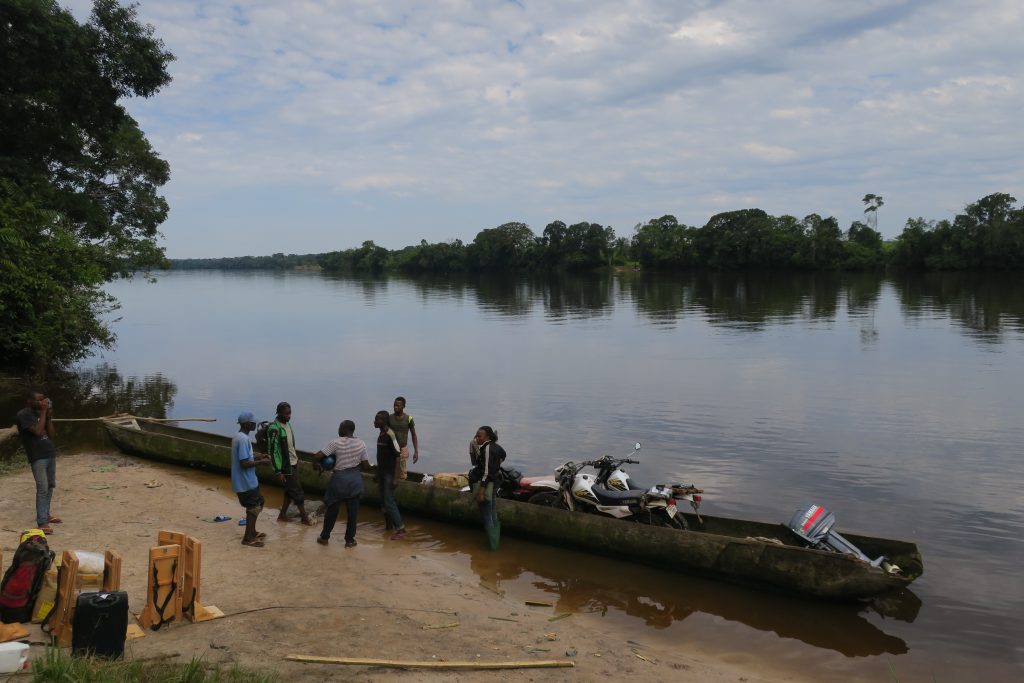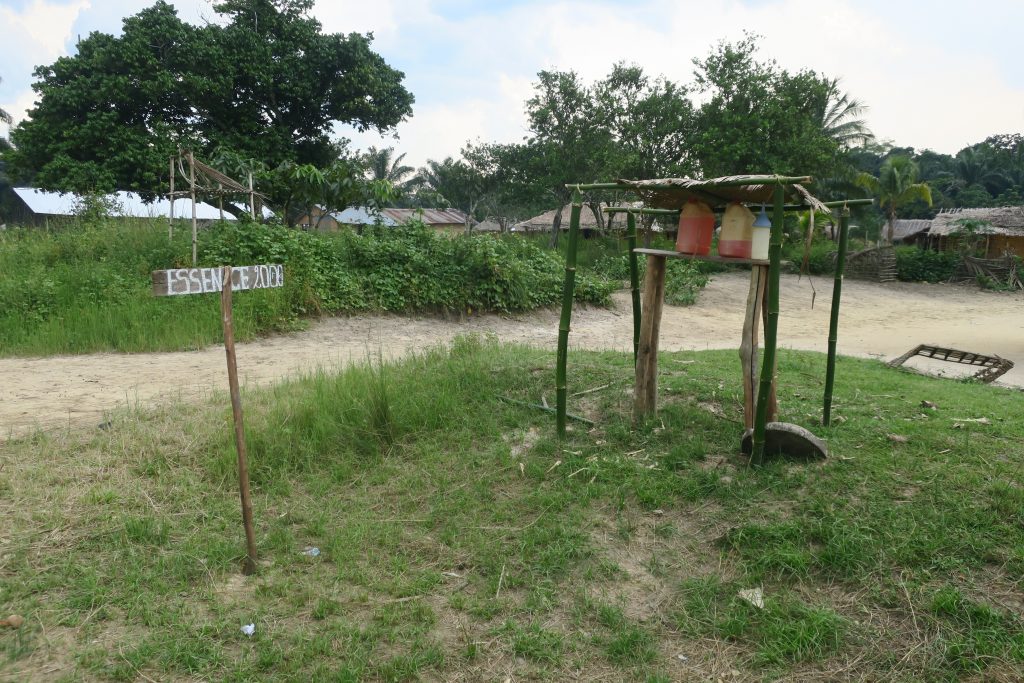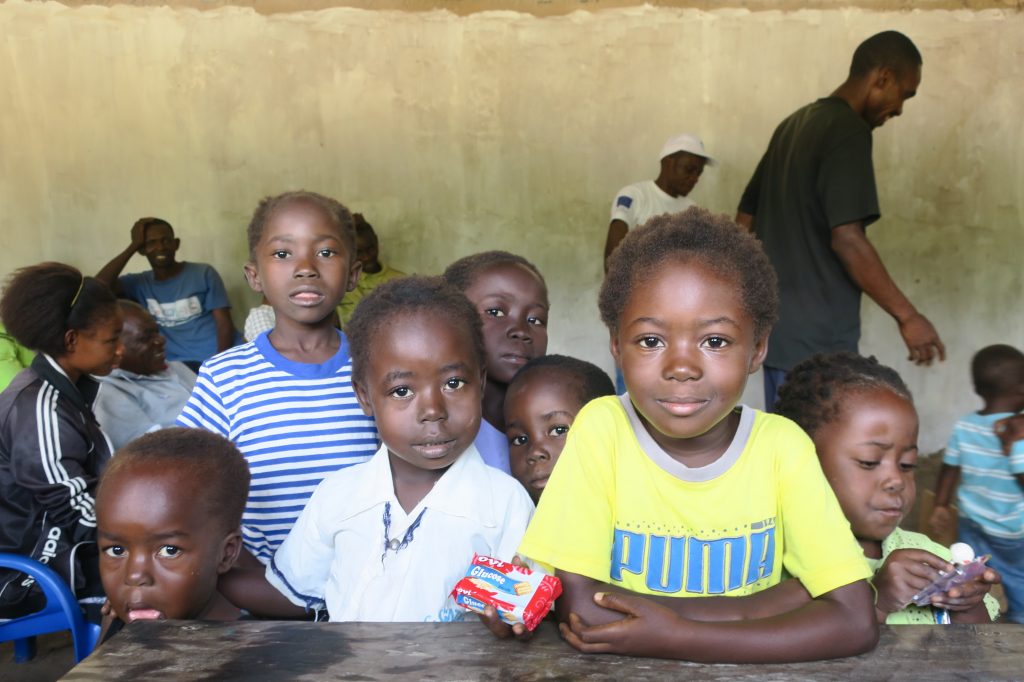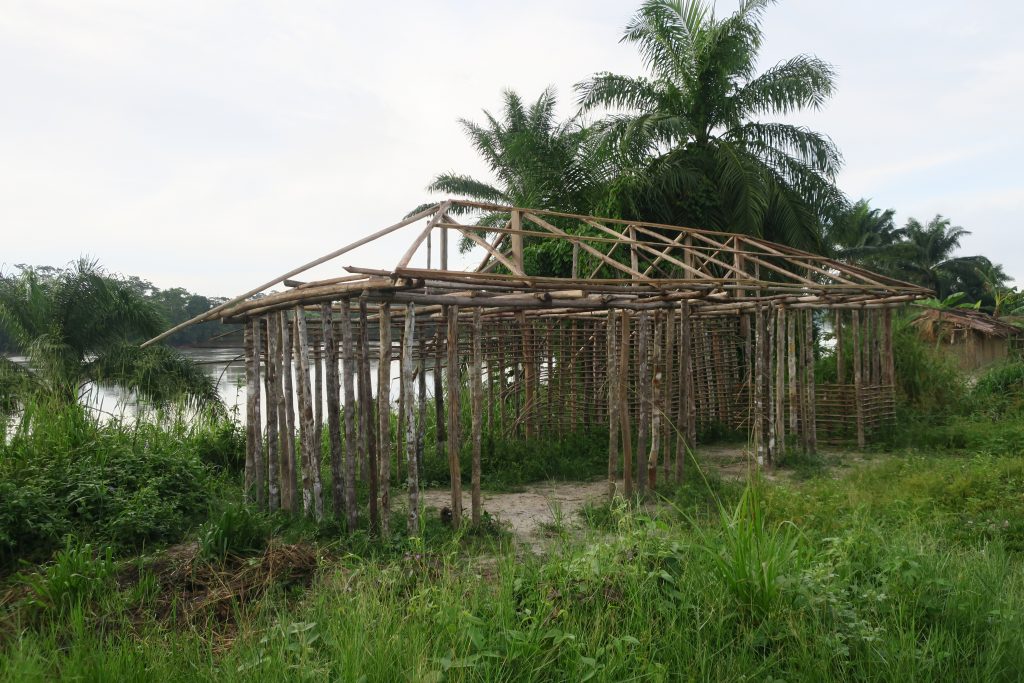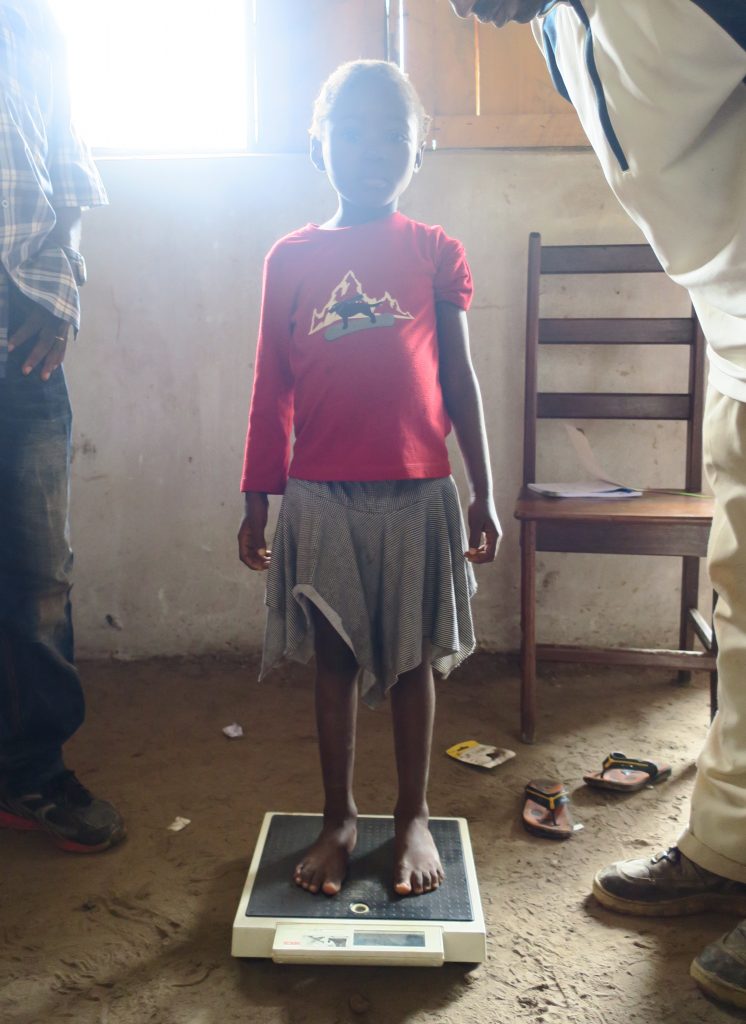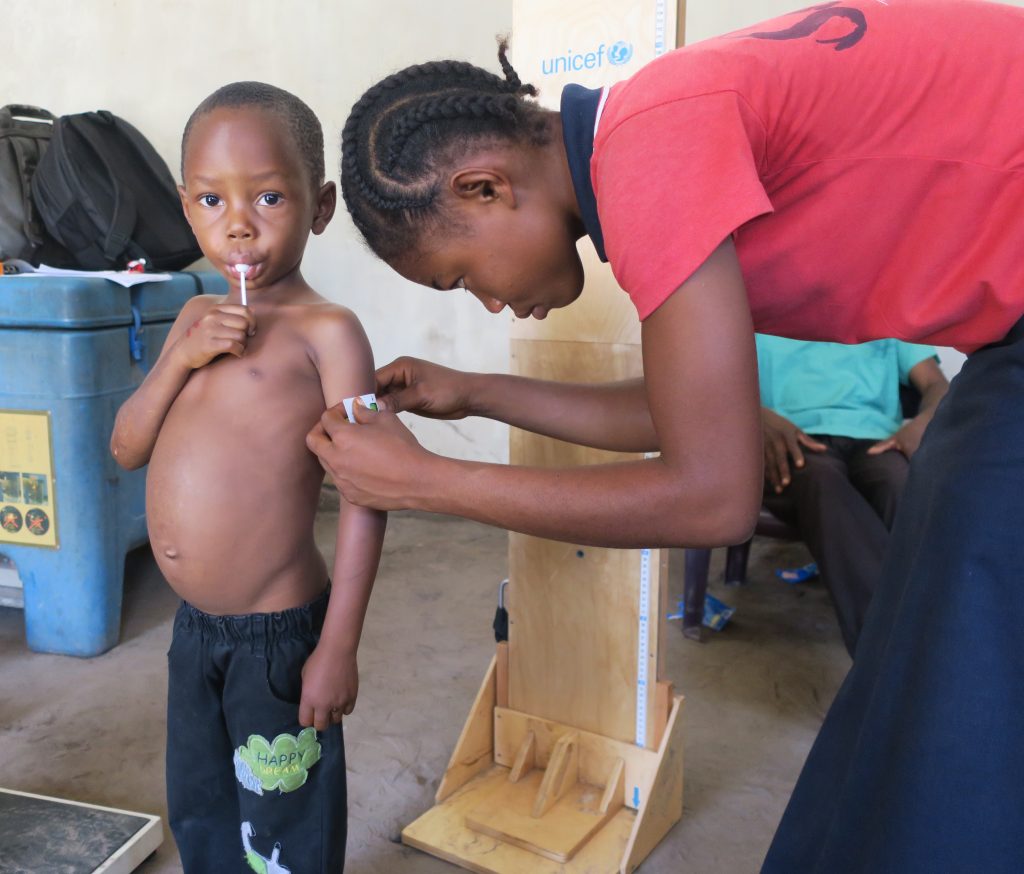Alexa Travels > The Journey > Humanitarian Musings > A Toast to a Village in the Congo
A Toast to a Village in the Congo
I recently had the honor of spending two weeks in a village deep in the second largest rainforest in the world of the Congo Basin. Getting to the village was an odyssey in and of its own. The Democratic Republic of Congo (DRC) is infamous for it’s lack of a developed road system. The UN estimates that only 1.3% of the DRC’s roads are paved with the country largely connected by rivers, trails, dirt roads, and a series of (sometimes decaying) airports. To travel from the national capital of Kinshasa to the province of Tshopo our team boarded a flight provided by European donors for humanitarian efforts. These planes are generally older, rickety, and defeaningly loud metal tubes hurtling through the sky. Our flight was no exception.
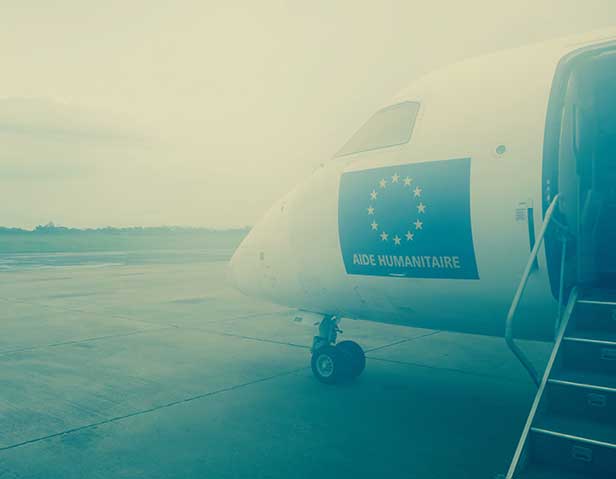
Humanitarian Flight to Kisangani
The next leg of the journey would be entirely on moto (motorcycles) because we would be traveling on trails too narrow for anything larger. We loaded up our supplies and ourselves and prepared ourselves mentally for the next 200+ jarring kilometers. The first hurdle in leaving the city of Kisangani was crossing the mighty Congo River. This was accomplished not by bridge or ferry, but by handmade “pirogues”, long boats carved from a single tree. Imagining the number of hours of toiling in the hot sun to carve a single pirogue was dizzying. The shoreline was chaotic, crammed with pirogues and swarming with people, motos, bicycles, and the occasional small livestock. I watched with amazement as our top-heavy motos were lifted and set into the pirogues–it was a feat of physics. We jumped in and perched along the edge of the lumbering vessels.
Pirogues Along the Shore in Kisangani
Once back on dry land we were off, leaving the urban chaos and plunging quickly into rural Congo. The bright orange roads stretched out before us and mud houses dotted the roadside. The day was hot, and the dusty dirt road crumbled beneath our bikes. In order to understand the DRC’s lack of infrastructure some contextual history is helpful. The DRC was first colonized by the Belgians, more specifically, King Leopold the II. While at the time the “Congo Free State” was painted as a humanitarian effort to civilize and unify the countless tribes while combating “Arab slave-traders”. In reality it was just the opposite. No schools were constructed and roads were only built to expedite the removal of resources from the country. The primary objective was exporting as much of the valuable resources of the day–ivory and rubber–for the king as possible. This was accomplished through widespread slave labor. Millions of Congolese were killed or worked to death. Despite small periods of grown and development, the legacy of poor infrastructure lives on today.
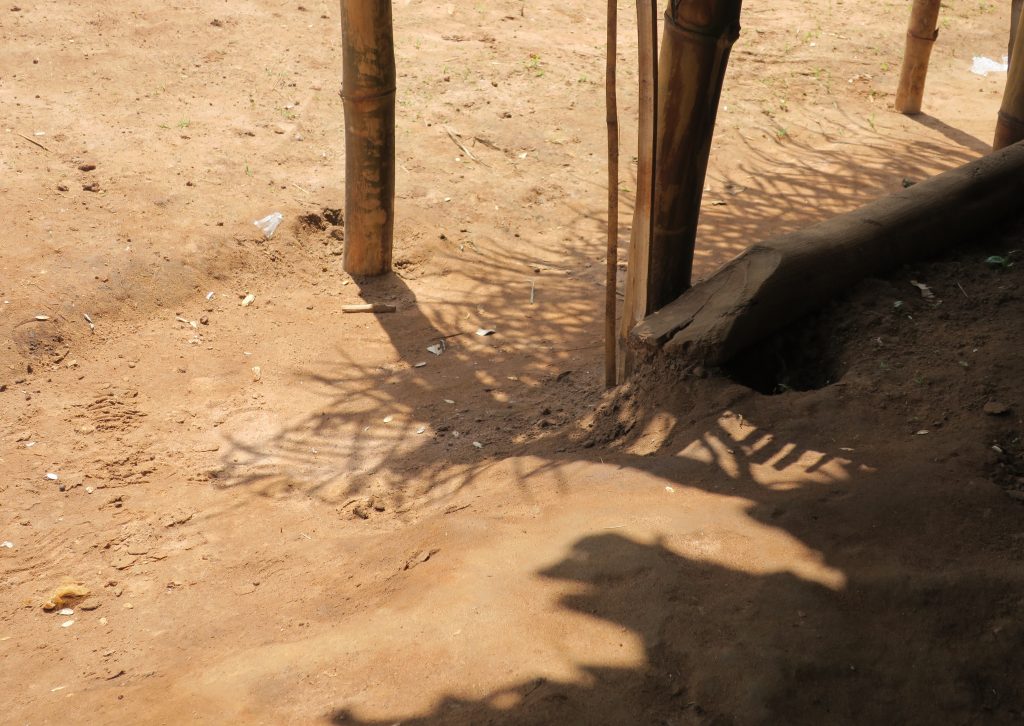
Taking a Break from the Long Dusty Road
As I studied the rural landscape from the back of my moto two things caught me by surprise. First was the presence of small solar panels in front of some of the mud houses. Propped up on rocks to angle the panes for the best sun exposure, I would later witness the connected batteries being brought inside homes in the evening to power lights and charge cell phones. I was amazed by this quantum leap in technology. Whole villages that had never had a powerline or a landline phone now had cell phones and solar powered lights. Maybe Africa will launch ahead of other nations into an era of renewable energy, with the same momentum as when the continent leapt from near 0% personal landline ownership to rates of cell phone ownership rivaling the US.
The second sight that caught me by surprise was seeing child-sized coffins for sale on the side of the road. They boasted bright floral patterns that were both macabre and sobering. It was a jarring reminder that the DRC has one of the highest infant mortality rates in the world at 69.8 deaths/1,000 live births. We sped on and the mini floral coffins were soon tiny pink dots against the burnt sierra skyline.
In the end it would be a twenty-four hour journey that involved multiple stops for mechanical issues, river crossings, arguments with local “officials” demanding money for various tolls and tariffs, and an overnight stay in a village along the way (show up and ask if you can pay $10 to stay the night, now that’s the original Airbnb!). For the final 20 kilometers on moto we plunged into the jungle following a narrow path. Branches reached for us hungrily and massive trees and the occasional bamboo towered above. Locals on rickety old bikes or on foot stepped off the path and watched our convoy of eight motos fly by.
We arrived at our final river crossing and said goodbye to our moto drivers who had faithfully delivered us and our supplies intact. After a peaceful journey up the Amazon-esque Lumami River our orange dust-coated team stepped off our last pirogue amid a flurry of wide-eyed kids in our destination village. We’ll call it “Kisanga”. We were shown to our lodging and prepared to make the rounds to meet with local officials. Work would begin the following day and there was much to be done.
Final Pirogue Crossing at the Lumami River
During our time in Kisanga I caught a glimpse of life for it’s residents. I will attempt to summarize my experience, acknowledging that I am merely scratching the surface. It would require much lengthier exposure and deeper inquiry to render a more complete picture of life here.
Kisanga is a quiet village nestled against the Lumami River. The residents speak Lingala, varying degrees of French, and some speak additional languages such as Swahili. In contrast to the idyllic jungle setting teeming with life, life in Kisanga is not easy. There exist no roads to the village, only an entanglement of trails and waterways. Products brought into Kisanga endure a long, punctuated supply chain, so they are relatively few.
Farming on a large scale is limited (farming takes money for inputs, cultivated land, well-functioning markets, and roads to connect farmers to said markets) and the few products grown and sold here include a local variety of rice and the ubiquitous manioc, which have to be transported by moto, rickety old bicycle, or by hand. Goats, sheep, pigs, and chickens roam the village. There is virtually no refrigeration, so meat is either consumed in a relatively short amount of time or smoked. With fish this means salting them heavily and smoking them. With animals this involves gutting the animal, opening the chest cavity wide, and smoking the entire animal (hide and all) until the exposed flesh turns shiny and black to preserve the meat inside. (I got a close look at a small deer that was prepared in this manner when a local woman brought the dried body to our door to sell it. While she was discussing the price with our team a few wriggly maggots fell to the floor. I was really glad we turned it down). Many food items are caught or foraged such as fish from the river, palm oil and bushmeat from the forest; but manioc stands out as the staple food. The leaves of this drought-resistant plant are stewed with oil and provide micronutrients such as vitamin C and Potassium. The manioc root (aka cassava or yuca) is laboriously pounded by hand until it becomes dough-like, and then formed into a ball called “fufu”. Manioc requires few inputs to grow and fufu is dense enough to fill one’s stomach, which is partially why many of the world’s poor in Africa, Asia, and South America rely on the hardy root.
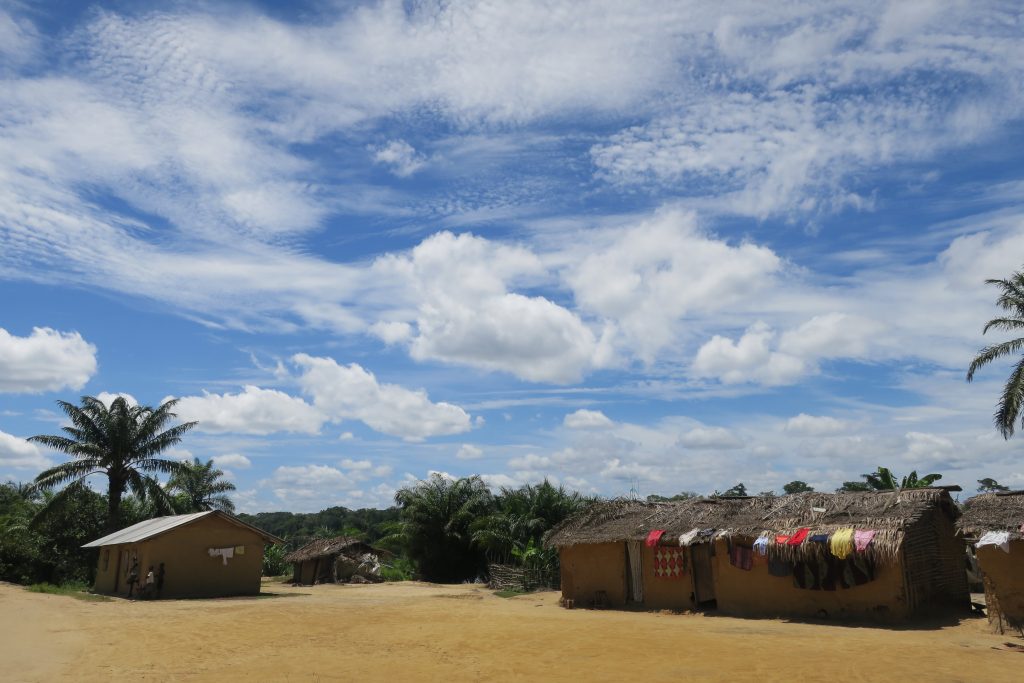
Breathtaking Sky Over Homes in Kisanga
Depending on their role in the village, the men work hard, but I don’t think they can compare to the women. Women work their fingers to the bone, often with an infant slung on their backs, bearing all domestic duties and the social expectation to bear numerous children. Women are married off as early as their fathers allow (sometimes 12 or younger) and polygamy is not uncommon. Housekeeping entails the never ending cycle of lugging water, gardening, raising small livestock, cooking, washing, and what I can only imagine is the eternal struggle to keep a household in order when your house is made of mud and your floor is itself dirt.
A Gaggle of Local Kids
The majority of the structures in the village are made of mud, aside from a few brick and cement buildings. For houses the frames are knobby wood poles from hand cut trees. The sides are packed with mud that dries to create the walls. Roofs are mostly made of dried palm leaves, although the wealthier households in the village have metal sheet roofing. I imagine that this method of mud house construction is very old. On one hand, it is possible to build a house from local materials and few inputs other than labor. On the other hand, living spaces are cramped and slowly crumbling. I felt great respect when I saw someone emerge from such a house dressed sharply in dress pants and a button up shirt. Keeping your clothes clean and wrinkle free in such a space must be an art form.
The Frame for a New House
But don’t allow me to mislead you–it’s not all slacks and button ups here. The people of Kisanga experience real poverty. Ragged shirts and holey pants abound. Many wear shirts with English slogans (a sign of America’s garment glut dumped a non-English speaking population) that don’t fit the context at all. A woman wearing a shirt advertising a biker rally in the Midwest, a little girl wearing a threadbare shirt depicting a dog snowboarding down a mountain (I guarantee she isn’t familiar with snow or snowboarding), a middle school boy with a shirt proclaiming “I tried rehab, but it cramped my nightlife”. What a privilege it is for the children of the world who wear clothes that reflect their culture and preferences, instead of wearing what the rest of the world has discarded.
A Young Girl Being Weighed
Children run as free as the livestock here, and the schools have few materials. The central hospital is bleakly under-stocked, as further affirmed by the painfully parasite bloated bellies of toddlers wandering in front of it. The hospital doesn’t have deworming medication, much less the therapeutic “Plumpy’nut” paste to treat the cases of severe malnutrition in the surrounding health zone it is responsible for.
Malnutrition is not uncommon in the village, as indicated by the bony collar bones, slim faces, round bellies, protruding belly buttons, and copper tinted-hair of some of the young children. I week into our stay I met a young boy who stood out from the other kids I had seen in the village, but I couldn’t put my finger on why. Then it hit me, this kid was well-nourished and positively glowing in contrast to the other kids. He could have been getting off the bus in the US with a Spider-Man lunchbox and looked every part the well-fed American boy. How quickly my eye had adjusted to a malnourished population startled me. Another day a mother brought us her one year old to inspect. The child’s feet, legs, and arms were swollen with fluid retention, a bizarre acute malnutrition side effect which at a glance can give the impression of a chubby baby.
Measuring the Circumference of this Child’s Upper Arm
(One of Several Indicators of Malnutrition)
Life in this village is hard for the strong, but unrelenting for the weak. Sick or injured animals are discarded or eaten, elderly women roam the streets with heavy loads of timber, plantains, or water jugs on their braced backs, held in place by a strap across their forehead. One day I saw a child with down syndrome in the village. She was unaccompanied, and looked especially confused and in disarray. With limited resources and time to dedicate to a family member who can’t contribute, I can only imagine what a struggle it is for a child with special needs.
So despite the swiftness of residents of Kisanga to smile and great you with a “bonjour” or “bonsoir” in passing, and their eagerness to learn and grow as individuals, the people of Kisanga are hurting. It is not a secret or a destiny. It is the real life plight of people condemned to survive in the context of poverty–the kind of poverty that erodes dignity and the spirit. I’m not going to ease your conscious with a patronizing comment such as “life in Kisanga is so simple, I bet they are happier than us westerners with our crime rates and mortgage payments and consumerism!” That is simply not true. Life is not simpler or better when the average life expectancy is 57, when you bury your children in small coffins, and when your opportunities for education and self determination are severely limited. We know that generally, folks living in poverty experience higher rates of depression. The real difference between a child dying from malnutrition in a village like Kisanga and a child from a wealthy western country (with it’s own economy enriched by the resources extracted from poorer nations) that has never missed a meal, is the unequal distribution of resources in our world today.
With my date of departure from Kisanga quickly approaching I began to extend my farewells. To the team I had arrived with that treated me like a sister and taught me some Lingala, to the local staff I had become accustomed to working with and laughing with daily, to the hard working women who cooked our meals in addition to their family’s, to the director of the health zone with his booming voice and big heart. When I told him I was leaving the project early to attend my sister’s wedding in the US, he congratulated me warmly and then asked for something. “On the day of the wedding”, he said, “we will be thinking of you and your sister in the US. There,” he continued, “you must raise a toast to the village of Kisanga.” I smiled and agreed whole-heartedly. This was something I could do. As different as these two worlds were, one thing we share is our love for our families and our celebration of occasions such as marriages. A toast in appreciation of this village in the Congo was literally the least I could do. I hope one day to do more.


